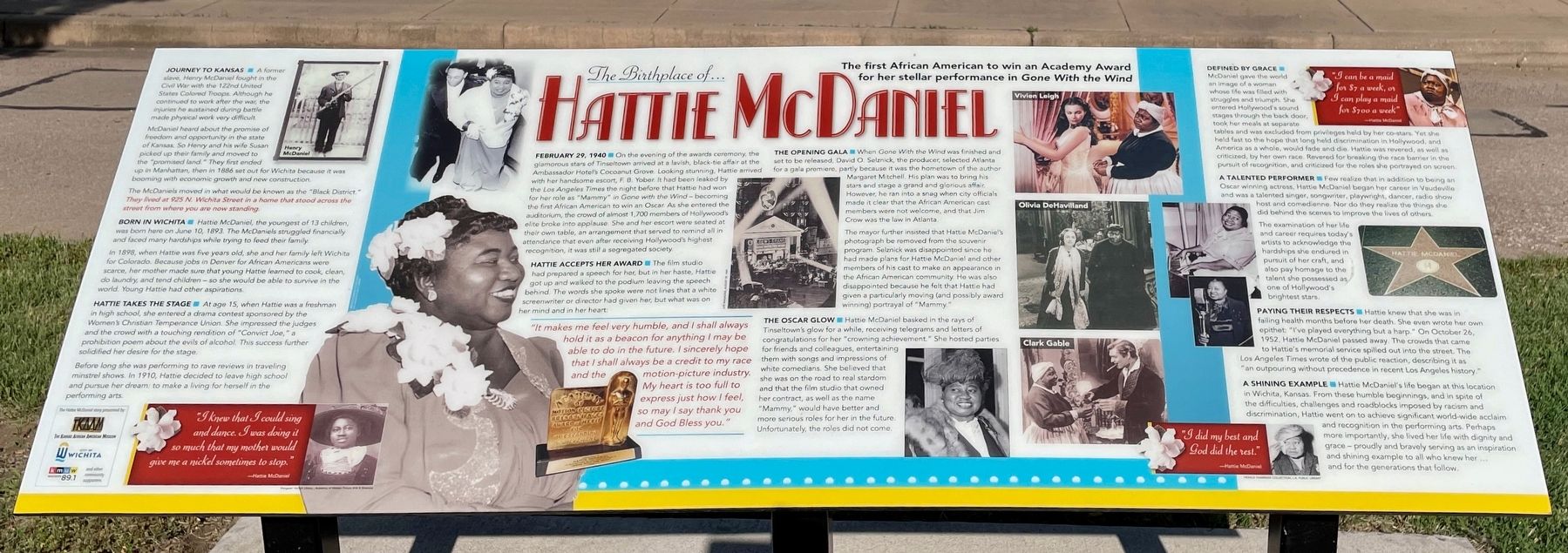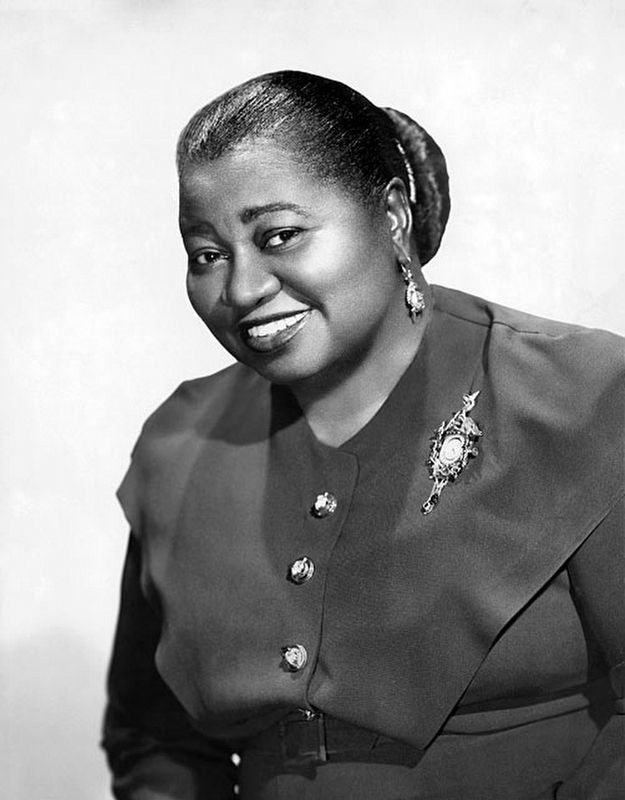Midtown in Wichita in Sedgwick County, Kansas — The American Midwest (Upper Plains)
The Birthplace of Hattie McDaniel
The first African American to win an Academy Award for her stellar performance in Gone With the Wind
Journey to Kansas A former slave, Henry McDaniel fought in the Civil War with the 122nd United States Colored Troops. Although he continued to work after the war, the injuries he sustained during battle made physical work very difficult.
McDaniel heard about the promise of freedom and opportunity in the state of Kansas. So Henry and his wife Susan picked up their family and moved to the "promised land." They first ended up in Manhattan, then in 1886 set out for Wichita because it was booming with economic growth and new construction.
The McDaniels moved in what would be known as the "Black District." They lived at 925 N. Wichita Street in a home that stood across the street from where you are now standing.
Born in Wichita Hattie McDaniel, the youngest of 13 children, was born here on June 10, 1893. The McDaniels struggled financially and faced many hardships while trying to feed their family.
In 1898, when Hattie was five years old, she and her family left Wichita for Colorado. Because jobs in Denver for African Americans were scarce, her mother made sure that young Hattie learned to cook, clean, do laundry, and tend children - so she would be able to survive in the world. Young Hattie had other aspirations.
Hattie Takes The Stage At age 15, when Hattie was a freshman in high school, she entered a drama contest sponsored by the Women's Christian Temperance Union. She impressed the judges and the crowd with a touching rendition of "Convict Joe," a prohibition poem about the evils of alcohol. This success further solidified her desire for the stage.
Before long she was performing to rave reviews in traveling minstrel shows. In 1910, Hattie decided to leave high school and pursue her dream: to make a living for herself in the performing arts.
"I knew that I could sing and dance. I was doing it so much that my mother would give me a nickel sometimes to stop."
—Hattie McDaniel
February 29, 1940 On the evening of the awards ceremony, the glamorous stars of Tinseltown arrived at a lavish, black-tie affair at the Ambassador Hotel's Cocoanut Grove. Looking stunning, Hattie arrived with her handsome escort, F. B. Yober. It had been leaked by the Los Angeles Times the night before that Hattie had won for her role as "Mammy" in Gone with the Wind - becoming the first African American to win an Oscar. As she entered the auditorium, the crowd of almost 1,700 members of Hollywood's elite broke into applause. She and her escort were seated at their own table, an arrangement that served to remind all in attendance that even after receiving Hollywood's highest
recognition, it was still a segregated society.
Hattie Accepts Her Award The film studio had prepared a speech for her, but in her haste, Hattie got up and walked to the podium leaving the speech behind. The words she spoke were not lines that a white screenwriter or director had given her, but what was on her mind and in her heart:
"It makes me feel very humble, and I shall always hold it as a beacon for anything I may be able to do in the future. I sincerely hope that I shall always be a credit to my race and the motion-picture industry. My heart is too full to express just how I feel, so may I say thank you and God Bless you."
The Opening Gala When Gone With the Wind was finished and set to be released, David O. Selznick, the producer, selected Atlanta for a gala premiere, partly because it was the hometown of the author Margaret Mitchell. His plan was to bring his stars and stage a grand and glorious affair. However, he ran into a snag when city officials made it clear that the African American cast members were not welcome, and that Jim Crow was the law in Atlanta.
The mayor further insisted that Hattie McDaniel's photograph be removed from the souvenir program. Selznick was disappointed since he had made plans for Hattie McDaniel and other members of his cast to make an appearance in the African American community. He was also disappointed because he felt that Hattie had given a particularly moving (and possibly award winning) portrayal of "Mammy."
The Oscar Glow Hattie McDaniel basked in the rays of Tinseltown's glow for a while, receiving telegrams and letters of congratulations for her "crowning achievement." She hosted parties for friends and colleagues, entertaining them with songs and impressions of white comedians. She believed that she was on the road to real stardom and that the film studio that owned her contract, as well as the name "Mammy," would have better and more serious roles for her in the future. Unfortunately, the roles did not come.
Defined by Grace McDaniel gave the world an image of a woman whose life was filled with struggles and triumph. She entered Hollywood's sound stages through the back door, took her meals at separate tables and was excluded from privileges held by her co-stars. Yet she held fast to the hope that long held discrimination in Hollywood, and America as a whole, would fade and die. Hattie was revered, as well as criticized, by her own race. Revered for breaking the race barrier in the pursuit of recognition, and criticized for the roles she portrayed on screen.
"I can be a maid for $7 a week, or I can play a maid for $700 a week"
—Hattie McDaniel
A Talented Performer Few realize that in addition to being an Oscar winning actress, Hattie McDaniel began her career in Vaudeville and was a talented singer, songwriter, playwright, dancer, radio show host and comedienne. Nor do they realize the things she did behind the scenes to improve the lives of others. The examination of her life and career requires today's artists to acknowledge the hardships she endured in pursuit of her craft, and also pay homage to the talent she possessed as one of Hollywood's brightest stars.
Paying Their Respects Hattie knew that she was in failing health months before her death. She even wrote her own epithet: "I've played everything but a harp." On October 26, 1952, Hattie McDaniel passed away. The crowds that came to Hattie's memorial service spilled out into the street. The Los Angeles Times wrote of the public reaction, describing it as "an outpouring without precedence in recent Los Angeles history."
A Shining Example Hattie McDaniel's life began at this location in Wichita, Kansas. From these humble beginnings, and in spite of the difficulties, challenges and roadblocks imposed by racism and discrimination, Hattie went on to achieve significant world-wide acclaim and recognition in the performing arts. Perhaps more importantly, she lived her life with dignity and grace — proudly and bravely serving as an inspiration and shining example to all who knew her … and for the generations that follow.
"I did my best and God did the rest."
—Hattie McDaniel
Erected by the Kansas African American Museum, City of Wichita, kmuw Wichita 89.1.
Topics. This historical marker is listed in these topic lists: African Americans • Arts, Letters, Music • Entertainment • Women. A significant historical date for this entry is February 29, 1940.
Location. 37° 41.973′ N, 97° 20.446′ W. Marker is in Wichita, Kansas, in Sedgwick County. It is in Midtown. Marker is on North Wichita Street north of West 8th Street North, on the left when traveling north. Touch for map. Marker is at or near this postal address: 928 N Wichita St, Wichita KS 67203, United States of America. Touch for directions.
Other nearby markers. At least 8 other markers are within walking distance of this marker. White Castle (approx. 0.4 miles away); The Historic Sedgwick County Courthouse (approx. 0.4 miles away); Civil War Soldiers and Sailors Memorial (approx. 0.4 miles away); John Cheney on Wichita State Basketball (approx. half a mile away); Spanish-American War Memorial (approx. half a mile away); North High School Indian Head (approx. 0.6 miles away); Gold Star Families (approx. 0.6 miles away); Bicentennial of the Birth of George Washington (approx. 0.6 miles away). Touch for a list and map of all markers in Wichita.
Credits. This page was last revised on June 1, 2023. It was originally submitted on May 14, 2023, by Mark Hilton of Montgomery, Alabama. This page has been viewed 182 times since then and 65 times this year. Photos: 1, 2, 3. submitted on May 14, 2023, by Mark Hilton of Montgomery, Alabama.


